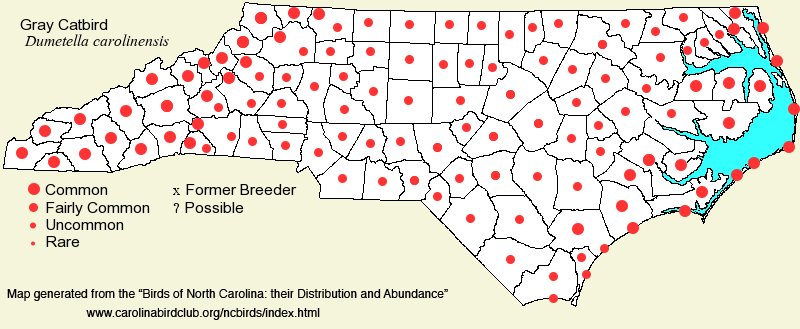 |  |
|
Gray Catbird - Dumetella carolinensis MIMIDAE Members: | Search Common: Search Scientific: |
|
|
|||||||
| General Comments | The Gray Catbird breeds over nearly all of the United States and southern Canada. It is a familiar yard bird in North Carolina, though it is a bit particular. No other state songbird seems to like as dark and damp conditions; it is most active in early morning and again late in the day. It breeds across the entire state, but it retreats mostly southward in fall, such that wintering birds are essentially limited to the Coastal Plain. Favored breeding habitats are dark and moist -- high elevation thickets and wooded edges, dense shrubbery in yards, pocosins, and maritime shrub thickets. In much of the state in summer, it is scarce away from cities and towns! In winter, it requires dense evergreen thickets with an abundance of berries -- pocosins, privet thickets in moist forests, dense wooded edges, and maritime thickets. | ||||||
| Breeding Status | Breeder | ||||||
| NC BRC List | Definitive | ||||||
| State Status | |||||||
| U.S. Status | |||||||
| State Rank | S5B,S5N | ||||||
| Global Rank | G5 | ||||||
| Coastal Plain | Permanent resident, with migratory movements. Along the northern and central coast, and in the Tidewater zone, common in summer; fairly common farther south near the coast. Inland, generally fairly common, though mainly restricted to wooded residential areas; scarce away from towns. In winter, little change in the Tidewater and the coast (common); however, farther inland, fairly common in central areas, but uncommon in the western portions; may not overwinter in some areas close to the Fall Line. Peak counts: 300, Cape Lookout, 5 Oct 2015. | ||||||
| Piedmont | Summer resident, and scarce winter visitor (straggler). In summer, fairly common on the whole, but mainly restricted to wooded residential areas of cities and towns (where it can be common in some such places); scarce in rural country and thus not numerous in many counties. Can be common in migration. In winter, rare in Dec, and very rare in Jan and Feb, and essentially not overwintering; mainly in the eastern and southern portions of the province. Mainly mid-Apr to mid- or late Oct. Peak counts: | ||||||
| Mountains | Summer resident, very scarce into early winter. In summer, common to very common in middle to high elevations, and common in the lower elevations; more numerous in the mountains than downstate in summer. Very rare to rare in low elevation valleys into early winter, but essentially does not overwinter. Mainly mid-Apr to mid-Oct. Peak counts: | ||||||
| Finding Tips |
None needed in the mountains in summer, and near the coast for most of the year. **** | ||||||
| Attribution | LeGrand[2023-03-27], LeGrand[2015-06-14], LeGrand[2012-09-27] | ||||||
| NC Map Map depicts all counties with a report (transient or resident) for the species. | Click on county for list of all known species. |
| NC Breeding Season Map Map depicts assumed breeding season abundance for the species. |  |